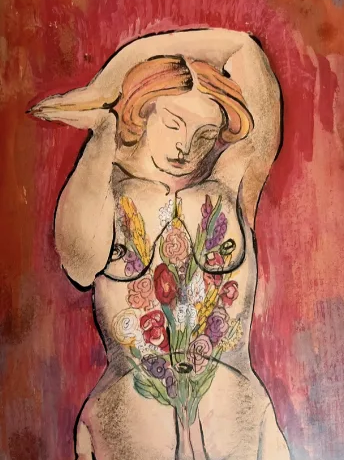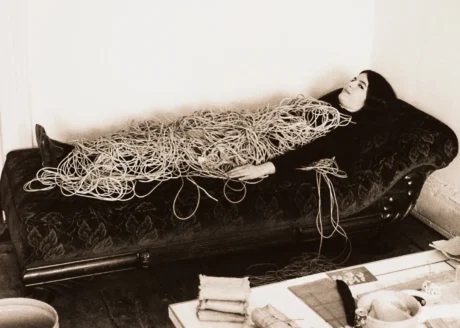
After February’s high tide of international artists, gallerists and collectors trotting down to Mexico City for art week, spring exhibitions can often be uneventful, an endogamy of burned-out artists recovering from the demands of the prior months and group shows overpacked with participants in loose curatorial stances, while public and private institutions rearrange their collections to try to say something new, and at best, take the plunge to do solo exhibitions with so-called emerging young creators. In congregations such as Zona Maco, Material Art Fair and Salón Acme, which have garnered major recognition in the past years, if you’re not participating in the project space section (where there’s no booth fees charged) it might be a struggle to break even as a gallery, but it’s still considered to be a more affordable investment than other international events of this order. When you’re not a blue-chip gallery, the buying interest of influencer it-girls and interior decorators turned art advisors can often fall through, securing a sale with collectors with whom there is no previous relationship is a rare instance. Armed with other reliable buyers in the First World, some international up-and-coming galleries decide not to continue participating in these exhaustive marathons, and just cherish (at best) their brief affair in the Latin American market and the fresh tuna tostadas gobbled down at Contramar (at worst, leading to an all too common bed-ridden food poisoning episode).
This time around Condo Complex invigorated Mexico City’s art landscape, an international initiative started by Vanessa Carlos that aims to have foreign galleries collaborate with local galleries that act as hosts of temporary exhibitions. A model that started in London in 2016, taken to New York City the next year, and replicated in other cities such as Shanghai, Athens and São Paulo since then, this was not the first time our capital had been implicated in such dynamic; it had already done so in 2018 and 2019. About half of the galleries participating in the other emissions returned to this year’s Condo Complex, a lot of them closed in the past years, and many new ones have popped up in since then. The particularities of the collaboration are up for the parties involved to decide: Doing a group show with artists represented on both sides; having the resident gallery take over a section, or all, of the local space. Artwork transportation logistics, payment of participatory fees (nothing in this world is for free), and sales percentages are likewise agreed between them. On the second week of April, Condo inaugurated shows of 42 galleries packed in 20 spaces around Mexico City. Visiting them all on the first opening days was an ambitious plan, but I had high hopes of getting to know new talents and finding artistic propositions outside of a purely commercial socialization.
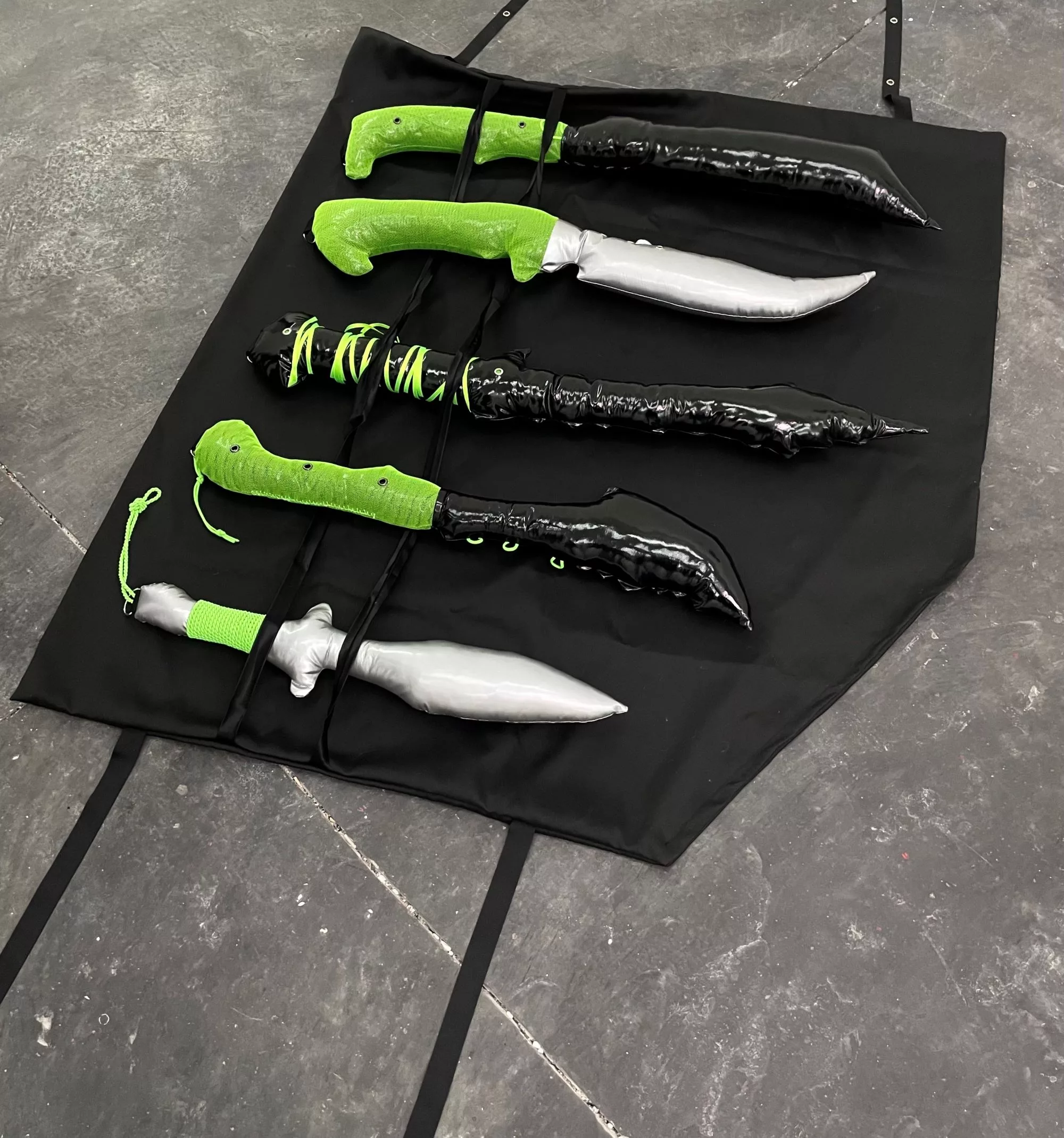
After a long day hopping around openings, I open myself a beer and make my way through the storefront steel curtain of General Expenses. One can always rely on them to keep it going on for a few hours after the stated closing time. This occasion the downtown site hosted the East London gallery Des Bains. In the main room, sculptures by Thomas Liu Le Lann (Switzerland, 1994) display a set of enlarged neon green plushy knives next to a deflated black vinyl figure with feline ears and elongated limbs that extend through the floor and go over a black swing hanging from the ceiling. The playful macabreness of the Swiss’ works relating to childhood trauma and emo culture creates a correspondence with the somber flair distinctive of the local gallery’s program and in-house artists. On the walls, tamarinds dangling from a tree and goats bopping their heads by Sara Knowland (UK, 1981) skillfully use impressionistic brushstrokes to create specks of light over the earthly subjects. Like other of her paintings, these convey a strong sexual and witchy undertone. Entering the backroom, usually darkened and used for video projections, bright red carpet and white light shine over Nour El Saleh (Lebanon, 1997) creations. On the bigger canvas, wrinkled bodies with black holes as nipples stare into the void while a hollow face floats above them. A small horizontal painting placed over white tiles presents a tiny insect-like humanoid floating in the mannerist hand of a face melting away to the nerve, and which contains unsettling details such as a minuscule smiling face portrait poking out of the corner. Yet another miniature work of a howling face has dry clay scrawny fingers opening a chest to a bare heart. El Saleh’s works, along with the constricted space and the sharp white light, make it all feel like a nightmarish acid trip.

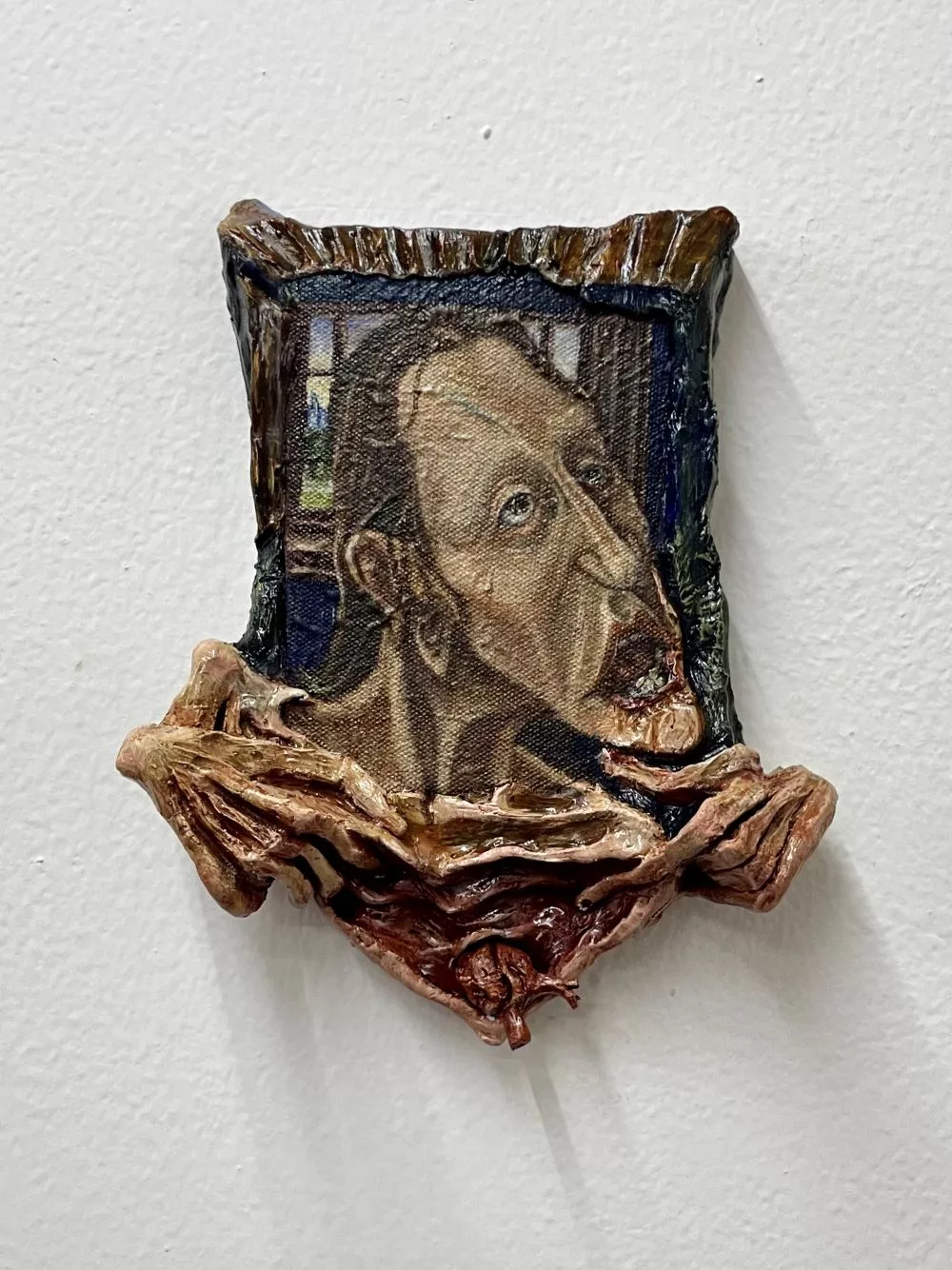
Battling a residual hangover the next day, the task of climbing up the stairs to the rooftop leading to Llano feels particularly exhausting. Finally there, the blazing heat of the sun is specially disorienting to find the right route towards the gallery. Standing like a mausoleum in a dessert, I enter the demure concrete room, which along with Guadalajara’s gallery Tiro al Blanco, conceived a solo exhibition of artist and performer Héctor Jiménez Castillo (Mexico, 1992). Novel, novicio, novato lays out small scale watercolors and acrylic paintings of caricaturesque bodies on linen canvases cleverly arranged in the obtuse corners of the space and white foamy webs in shapes assimilating broken chainlink fences and amalgamations of thorny strands. Taking inspiration on the images of funerary rituals across cultures, the outlined figures are seen standing, dancing and copulating. In a line-up of canvases, a procession of red and blue tinted bodies grab each other’s shoulders as they step on piles of agonizing corpses. Simplified to the essential lines, the gestures and movements of the figures hold great dramatic expression. Details certainly informed by Héctor’s own body of research as a founding member of the Arrogante Albino collective, who about a year ago turned the main room of Mexico’s Nordenhake outpost into an insane asylum by running a three day long act of naked bodies twitching and jerking in repetitive motions around a scaffold and wrinkled sheets of paper.

On my way to N.A.S.A.L, my husband spams me with Twitter screenshots of the breaking news of Iran launching missiles towards Israel, by the time I arrive to the place, I’m convinced WW3 has initiated. In there, I find a group show titled Actos de Fe organized with Peruvian gallery Revolver. The text, written by one of the participating artists, Luis Enrique Zela-Koort (Peru, 1994) meditates on the cult of violence and crumbling systems of beliefs. Following his exploration of desire as a force ingrained in the cellular and the cosmic realm, what he denominates, Queer Metaphysics, Zela-Koort’s work in this material domain displays a fractal cross made out metal with heart shaped amber-colored rubber fitted on grids of squares across it. The sacred geometry motifs continue in Artemio’s (Mexico, 1976) embroidered mandala made up of firearms, a sinister human-made technology created in the name of progress and fatally leading to our destruction via ideological justifications. Giancarlo Scaglia (Peru, 1981) depicts in an oil painting a red sundown reflected in moving sea waves, in the horizon is the island of El Frontón, a site of many histories, home to viceregal pirates, later on made to be a penal colony, and subsequently, the setting for a bloody massacre of Maoist militants. Seemingly lighthearted at first glance, Jose Carlos Martinat took a piece of a street mural with layers of electoral iconography that has on its foreground the playmobil-like face logo of La Cholita, a regional political contender of Peru representing the rural working class. The stacking of these different propagandistic signs points out to the spectacle of broken promises of change by those who rise to power. Ah! To be alive during these turbulent times of late stage technocratic-capitalism. The works at N.A.S.A.L reflect on the microcosmic–macrocosmic dimensions of the world we inhabit and how we assimilate reality. I ponder on how these human experiences are all but a glimpse in the vast history of the collective consciousness of our civilization, the particularities of most of these stories will be forgotten, and the violent nature of our species is doomed to repeat the same mistakes.

A lighter Saturday morning, I get a dose of caffeine and walk around the galleries of the San Miguel Chapultepec neighborhood. I step into the slightly-villanesque towering cement building that houses Anonymous Gallery and Relaciones Públicas, which in turn, are hosting the movable (but now Paris-based) Fitzpatrick Gallery and England’s Rose Easton. On Relaciones Públicas’ side, the two person show Luxury is Personal welcomes visitors to recline on a 350 kg bronze sofa by Arlette (Mexico, 1998). Having a background in fashion with items coveted by high-profile rappers that address symbols of traditional masculinity through the heavy duty medium of metal welding, this monumental commodity reveals the backside of a golden god when wandering around it; a cross-tattooed muscular torso with wiry wings is embossed on the asset’s behind. On the walls, the play of social commentary and humor characteristic of Martine Syms (US, 1988) is distilled in collages that assemble airplane tickets, paper shopping bags of designer items, kewpie mayo wrappers, and other assorted expensive litter. These works were first showcased in a 2021 show that originated from Syms’ attendance to a Janet Jackson wardrobe auction where she acquired an Alexander Wang jacket of the singer. The exhibition serves as a slightly sickening mirror of our consumerist-aspirational habits, the cult of icons and the tribal nature of the exclusive. Moving on to Anonymous’ main room, what first catches my eye is Cristine Brache’s (US, 1984) eerie portrait of a face fronting serious-looking woman with Playboy bunny ears. It’s like peaking in into the secret life of Laura Palmer. With encaustic as a top layer in hues of blue and green that remove the sharpness of the image, the painting emits a ghostly impression of sexual objectification and hyper-femininity. The parallel wall spells “CHICKS WITH DICKS” in black vinyl letters, and sitting on the floor, neon green dildos accompany furry baby chicks by Puppies Puppies (Jade Guanaro Kuriki-Olivo) (US, 1989). Another duo of paintings by Frances Stark (US, 1967) titled “Crow Attacks Dove Released by Pope in Ukraine in 2014” shows a white seagull and a black crow picking on a dove, the image contains the force of primitive competitiveness and power displays, a premonition of our violent times. Together, the shows at Anonymous / Relaciones Públicas thread a larger commentary on our self-absorbed lifestyles.
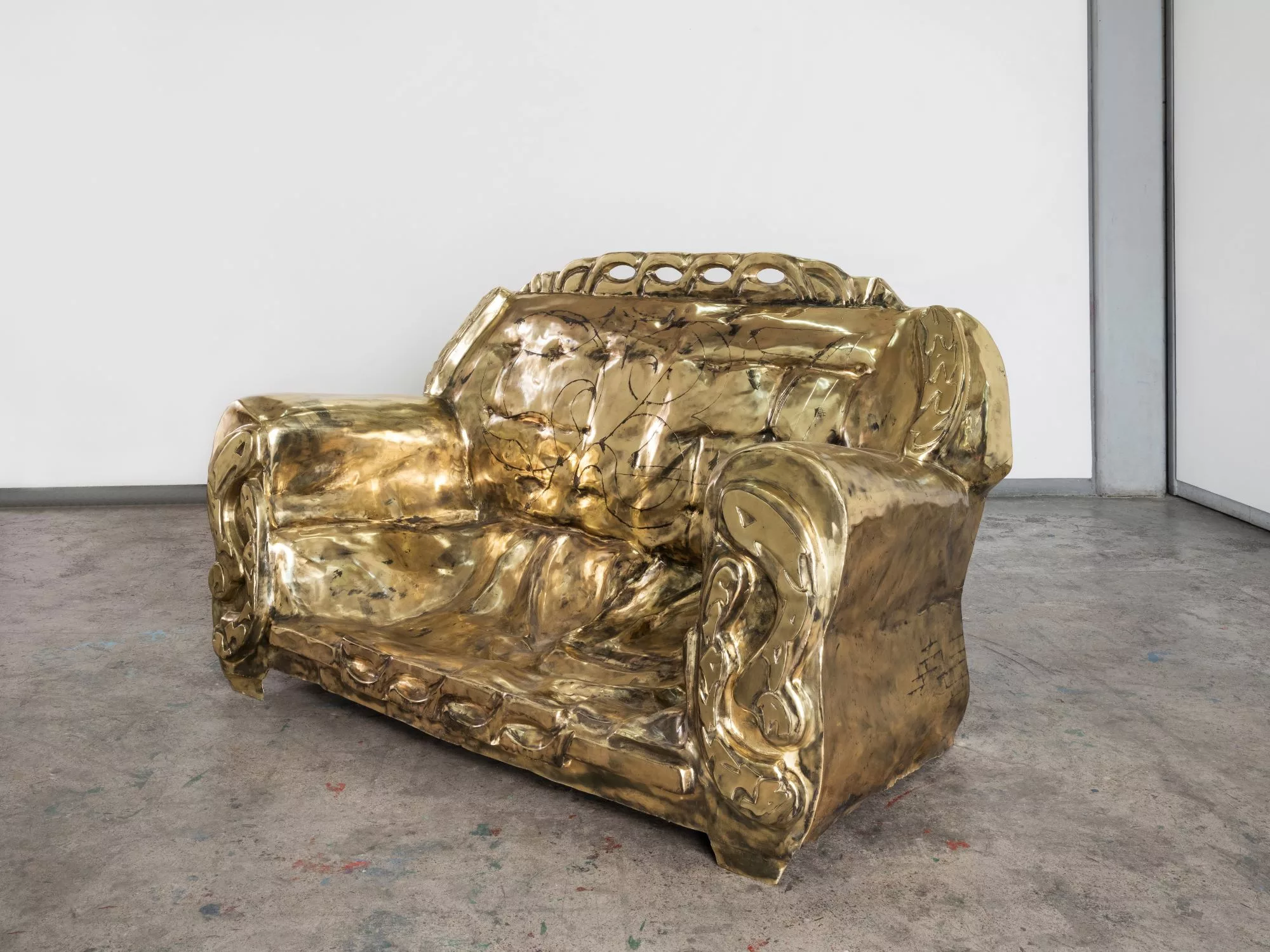
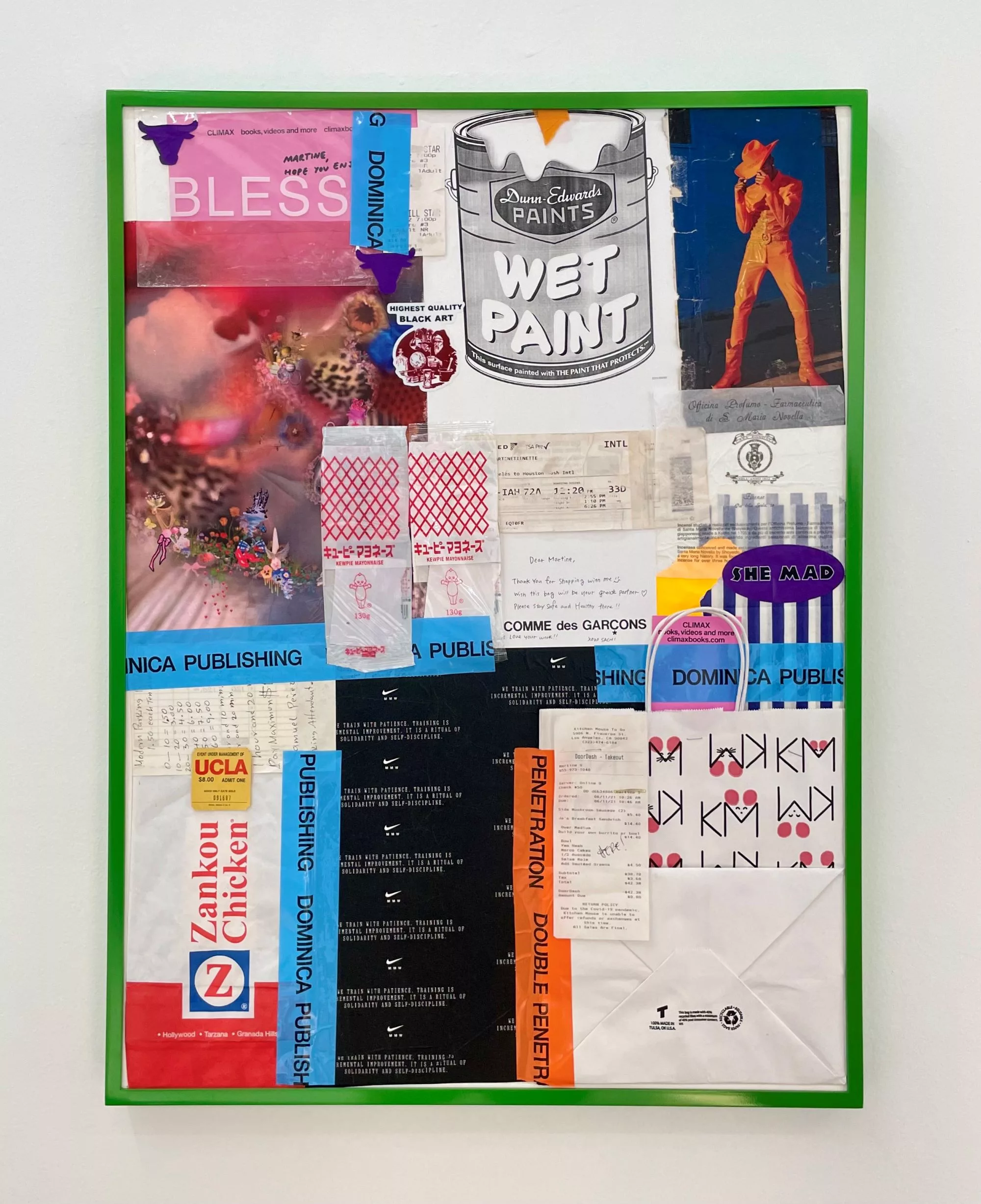
The popularity of art fairs has certainly been a catalyst for the ongoing production of more demanded mediums such as painting and sculpture. Hard to believe for some, there was a time in the early 2010’s in Mexico City where painting was frowned up, deemed an obsolete medium, and cerebral emotionally unattached conceptual art was favored. When trying to save on transport costs, canvases are the easiest to transport, rolled up in unassuming cardboard tubes and piggybacked in personal bags on international runs. Risk sending artworks the proper way, say shipping them on a crate, and they might get stuck for months in customs for obscure reasons. A safer bet and enriching experience for all involved is bringing outsiders on a residency to produce works here, that way the stress of opening on time can be canalized to the artist rather than an unresponsive customs agent. Without the urge of having to pay back the costs of overpriced ephemeral drywalls in convention centers, and partially less parties and buzz, this season has given galleries some headspace to create interesting convergences between outside artists and their usual programs. Condo’s mission to establish an alternative model of collaboration between art spaces does venture out of more blatant money-oriented dynamics (and indeed it turns out to be unprofitable for a lot of the participants). In the least, the nuclear cliques mingle and get down to business with their international colleagues. All a tight-knitted family affair still, like having some rich distant cousins visit the city.

There’s something to do everyday in Mexico City’s contemporary art scene, the numerous galleries often keep their program busy hosting performances, radio shows, screenings and pop-up stores; museums organize free festivals, concerts, workshops and symposiums. Nights are filled with sleaziness in artist-run clandestine bars, cinemas and raves. It’s certainly fun to enjoy this city as a cosmopolitan spectator, but many times locals don’t get to dwell in the hedonistic pleasures that come from being a master of your time and the security a strong currency can bring. It’s a land fertile for El Dorado fantasies and rebirthing-rebranding yourself. But not all that shines is gold here, and when not dazzled by the shiny lights of the fast life, taboo questions such as who is really living off their art, who has a secret day job to support their bohemian lifestyle, or who is a trust fund baby, circle the heads of many. This is probably a scenario that replicates in any big culture-hub city; the art world just makes precarious work conditions and sedimented class hierarchies more evident. Aside from dealing with the surge of rent prices and an imminent water crisis, the city is bustling with massive creative overflow generated by individuals coming from diverse backgrounds and exploring all kinds of artistic endeavors. Those who stay for the long term have to develop a strong resilience. You got to learn to breathe through ozone contingencies and volcanic ash currents, and suit yourself for the high altitude and earthquakes that can bring long-standing structures to the ground.
Written by Fabiola Talavera



